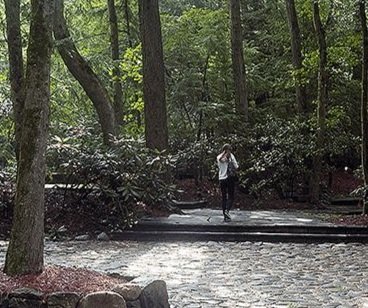Later Works
Whereabouts in Japan?
In his later works Rose continued to explore modern American themes, while creating gardens for contemplation and self-discovery as he discovered a mirror fusing his modern American landscape experience to the ancient culture of Japan in the sixties. Some have accused him of doing Japanese gardens, but little would make him madder. In fact, in response to a prospective suburban New Jersey client’s query as to whether he could do a Japanese garden for her he replied, “Of course, whereabouts in Japan do you live?”
Sculptural compositions of space
As in his earlier gardens, Rose’s later works continue to explore the nature of landscape space. “I have found it helpful to think of a garden as sculpture…,” he wrote, “…not sculpture in the sense of an ordinary object to be viewed. But sculpture that is large enough and perforated enough to walk through. And open enough to present no barrier to movement, and broken enough to guide the experience, which is essentially a communion with the sky.”
His understanding and expression of the richness of landscape edges grew while materials used became simpler for the most part—rocks, plants, earth and water. He refined his approach to dealing with clients and responding to sites; and his method of working, generally. The later gardens became more spontaneous and improvisational, often recycling raw materials found on site and incorporating natural features like rock outcroppings and trees as part of a designed, flexible, irregular, asymmetrical spatial geometry. Abhorring waste, Rose would often re-use discarded building materials and constructions originally intended for other purposes. Old doors became elegant garden benches, metal barbecues turned into fountains, railroad ties became walls for irregular garden terraces. Overall, Rose’s later gardens are highly ordered sculptural compositions of space meant to be experienced rather than viewed. They are like giant origami, the experience of which unfolds from the inside.
Magnum Opus
Rose continued to develop his own residence at Ridgewood for the almost forty years he lived there. Just two of the major changes are the addition of a roof garden and the enclosing as shelter of some of the outdoor space. The result is a thoroughly interwoven expression of indoors and outdoors that Rose described as, “neither landscape nor architecture but both; neither indoors nor outdoors, but both.”
James Rose Garden Documentation Project
Due to the spontaneous nature of Rose’s method, little documentation of his later works existed. Thus one of the first activities of the James Rose Center has been to document as many of his projects as remained intact. To date nineteen such gardens have been thoroughly documented in a series of drawings, photographs and descriptive texts, providing a record for students and scholars. For an example of one of those projects, refer to Anisfield Garden.



